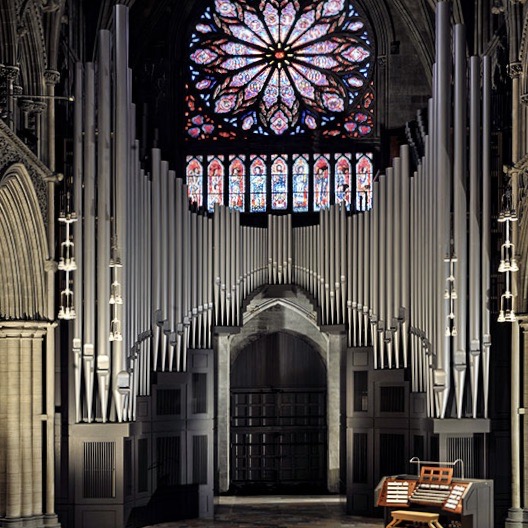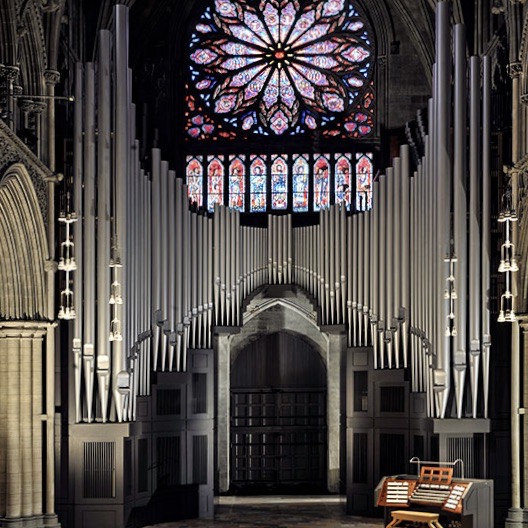STEINMEYER
Nidaros Cathedral Trondheim
Organ details
History
The main cathedral organ of Nidaros cathedral, is the monumental Steinmeyer organ with 129 stops, built in 1930. With more than 9.600 pipes, it is one of the largest instruments in northern Europe.
As the organ was built, the western part of the cathedral nave had still not been finished when the new organ arrived from Oettingen, Bavaria. So the organ was erected in the north transept, taking up the whole floor space of the transept. The console, on wheels, stood in the crossing of the cathedral. The organ was inaugurated for the 900th anniversary celebrations of the battle of Stiklestad.
The great nave of the cathedral had already been completed for more than twenty years when the decision was taken in 1960 to place the organ at a distance in front of the cathedral's west wall. The facade still consisted of the case of the former baroque organ, originally built in 1741 by Joachim Wagner. Since this front was much too small for the organ it stood on a projecting gallery, on which the console was also placed. The pedal organ was located behind this gallery, directly on the cathedral floor. The windows, including the wonderful rose window, were still visible above the organ.
The concept and style of the organ as such had undergone significant changes since the instrument was built. The time when organs had over one hundred stops and an electric action had passed, neo-baroque organs conformed to the spirit of the time. Thus the Steinmeyer organ lost a number of its 16' and 8' stops. The swell organ of the third manual moved into the triforium at the front end of the nave, where, with some additions, it was used as chancel organ from then on. The swell organ of the second manual survived as a single unit. It was placed in front of the west wall at the northern end of the triforium, where the height of the interior does not allow for open 16' stops. The windchests of the great organ, the choir organ and small pedal organ found their place on the gallery. The high pressure stops and the chests of the solo division were removed in their entirety. Many pipes of the 16' and 8' stops were put into storage, being no longer needed. When a fire occurred in this storeroom, wooden pipes, English tubas and other metal pipes were destroyed, whilst the damage to many zinc pipes was almost as destructive, following repeated storage.
The historical case front was removed from the Steinmeyer organ in 1994, as a consequence of the restoration/reconstruction of the Wagner organ in the north transept. The «innards» of the Steinmeyer organ were now on view to all comers, a far from pretty sight!
The planning of a restoration of the complete Steinmeyer organ started already in the 1970s, less than 15 years after the organ had been reduced and relocated in the western part of the cathedral.
In 2007 it was finally decided that the organ was to be preserved and restored back to its original condition from 1930. The location was determined for the cathedral's west wall, under the rose window.
In November 2012, the Swiss firm Orgelbau Kuhn AG started the restoration of the organ and in September 2013, the reconstruction of the 40 ton heavy organ in Nidaros Cathedral started.
In May 2014, in connection with the grand national constitution anniversary in 2014, the Steinmeyer organ was once again inaugurated in Nidaro's cathedral.
Multimedia library
Specification
| I. Hauptwerk C-g3 | II.Positiv C-g3 | III. Svellverk C-g3 | IV.Fjernverk C-g3 | Pedal C-f1 | |
| Principal 16 Bourdon 16 Principal I 8 Principal II 8 Principal III 8 Flauto major 8 Doppeltgedeckt 8 Violoncello 8 Rørfløite 8 Gemshorn 8 Kvint 5 1/3 Oktav 4 Principal 4 Fløite 4 Gross Ters 3 1/3 Kvint 2 2/3 Superoktav 2 Ters 1 3/5 Cornet 5fag Mixture 6fag Cymbel 3fag Bombarde 16 Tromba 8 Trompet 8 Clairon harmonique 4 Celesta Chimes | Nachthorn 16 Salicional 16 Principal 8 Spissfløite 8 Gedeckt 8 Dulciana 8 Unda maris 8 Kvintaten 8 Principal 4 Fugara 4 Røhrfløite 4 Kvint 2 2/3 Sifflöte 2 Ters 1 3/5 Larigot 1 1/3 Septim 1 1/7 Sedecima 1 Mixtur 4fag Contra Fagott 16 Bassetthorn 8 Clarinet 8 Trompet 8 French horn 8 Euphone 4 Tremolo II. Rückpositiv Mildprincipal 8 Violfløite 8 Cor de nuit 8 Prestant 4 Bachflöte 4 Nasat 2 2/3 Blockflöte 2 Nachthorn 1 Cymbel 4fag Ranket 16 Krummhorn 8 Tremolo | Geigenprincipal 16 Røhrfløite 16 Principal major 8 Principal minor 8 Jubalfløite 8 Wienerfløite 8 Bourdon 8 Viola di Gamba 8 Gamba celeste 8 Aeoline 8 Voix celeste 8 Prestant 4 Gambette 4 Flûte harmonique 4 Kleingedeckt 4 Kvint 2 2/3 Piccolo 2 Ters 1 3/5 Cornet 5fag Plein jeu 5fag Trompet 16 Trompet harmonique 8 Cornopean 8 Orkesteroboe 8 Vox humana 8 Clarin 4 Harpe 8 (Tr.) Harpe 4 (Tr.) Tremolo | Bourdon 16 Viola 8 Viola celeste 8 Bourdon 8 Principalfløite 4 Flageolet 2 Mixtur 3fag Trompet 8 Vox humana 8 Pedalbourdon 16 (Tr.) Tremolo IV. Solo Diapason Stentor 8 Geigenprincipal 8 Grossmixtur 5fag Tuba 16 Tuba 8 Trompette orchestrale 8 Tuba 4 | Subbourdon 32 Contraviolone 32 Majorbass 16 Principalbass I 16 Principalbass II 16 (Tr.) Contrabass 16 Harmonikabass 16 Subbass 16 Bourdon 16 (Tr.) Salicional 16 (Tr.) Quintbass 10 2/3 Oktavbass 8 Principal 8 (Tr.) Violoncello 8 Dulciana 8 (Tr.) Røhrfløite 8 Fløitebass 8 Kvint 2 2/3 Oktav 4 Bachflöte 4 Ters 3 1/5 Waldflöte 2 Mixtur 5fag Pedalcornet 5fag Contra bombarde 32 Bombarde 16 Basstuba 16 (Tr.) Fagot 16 (Tr.) Ranket 16 (Tr.) Trompet 8 Clarin 4 Chimes (Tr.) | Couplers: I-P, II-P, III-P, IV-P, Super II-P, Super III-P, II-I, III-I, IV-I, Super II-I, Sub II-I, Super III-I, Sub III-I, Super IV-I, Sub IV-I, III-II, IV-II, Super II, Sub II, Super III-II, Sub III-II, Super IV-II, Sub IV-II, Unison II off, IV-III, Super III, Sub III, Super IV-III, Sub IV-III, Unison III off, Super IV, Sub IV, RP-P, RP-III, RP-II, RP-I |
Generals and divisional pistons.
Touch screen with additional functions, such as Kuhn Setzer system,
Interval cuouplers, MIDI-recorder.
Temperament: Equal.
Tuning: 442 Hz (by 20 °C)
Events
Take a look at the below list of events and visit one.











